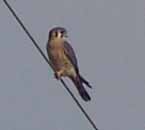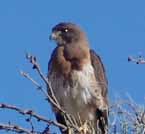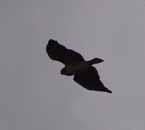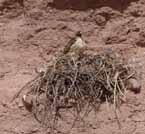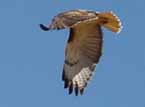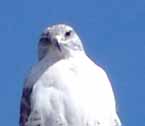Raptors (Hawks, Eagles, Falcons and some others)
Members of the Order Falconiformes are prototypically diurnal carnivorous predators, with strong legs, sharp and grasping claws, and a sharply hooked beak. A number of kinds of raptors are common in our Arizona Uplands Sonoran Desert, some year-round and some migratory. We have seen many on Saguaro Juniper lands, but have rarely had camera access when these spectacular creatures appear.
Golden Eagle (Aquila chrysaetos)
We have no photographs yet of this massive raptor, but Daniel Baker has seen them very occasionally in Hot Springs Canyon. Once he saw two Red-tailed Hawks harassing a single Golden Eagle in the air as the eagle was soaring. Soon after, nearby, he found one dead Red-tailed Hawk on the ground -- disemboweled.
Buteos
Red-tailed Hawk (Buteo jamaicensis)
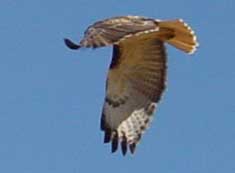 ..
..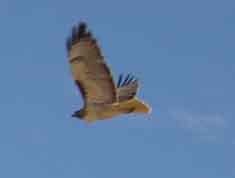
The Red-tailed Hawk is surely our most common raptor, and lives with us year-round. (Its frequency however varies with drought conditions -- predators high on the food chain must stringently limit their numbers during hard times.) A magnificent Buteo (the larger, heavy-set hawks with broad, rounded wings and short, broad tails), it usually keeps its distance from humans. Click on each of these images to enlarge it. The enlargements here better show details and color contrasts in this adult -- black tips on the wing primary feathers; a dark mark along the front of the wing, and the red tail, which however often looks more yellowish from below, more rufous when seen from above.(Note also that the belly of this bird has a pale yellowish cast.) Overall, this looks like a fairly typical Southwestern Red-tailed adult.
We photographed this Red-Tailed perched on a power pole along the Cascabel Road in early February 2007. Click on each image to enlarge it.
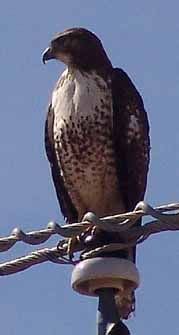 ...
...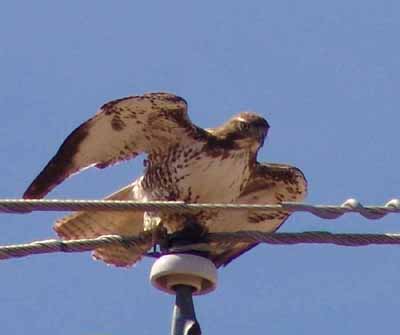 ...
...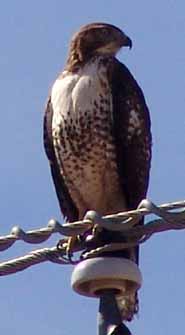
We were uncertain what species of Buteo this bird was until we caught it beginning to fly away (center image), when dark wing fronts and tips gave a clear indication. But the paleness of the underside and of the tail strongly suggest that this is a Southwestern Red-tailed Juvenile, not an adult bird (see Sibley 2003 p.107).
Since we now have many images of our Red-tails, we have decided to devote a separate page to chronicle a fuller spectrum of these birds:
Red-tailed Hawk
Swainson's Hawk (Buteo swainsoni)
A Buteo similar in size to the Red-Tailed but with longer and more pointed wings, this dark-breasted hawk summers widely in the intermountain West but winters in South America. We photographed this one in May of 2004.
(Click on each image to enlarge it.)
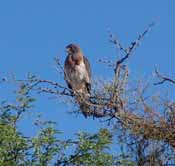 .
.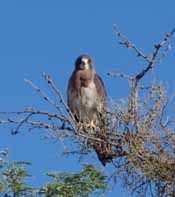 .
.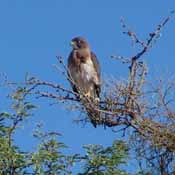
Ferruginous Hawk (Buteo regalis)
This largest species of our Buteos winters in our area, but breeds further north. We don't see them very often here. The male juvenile shown below was resting on a power pole along the Cascabel Roadway in February 2001.
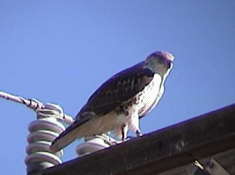
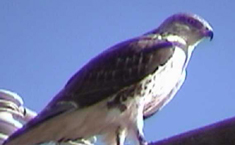
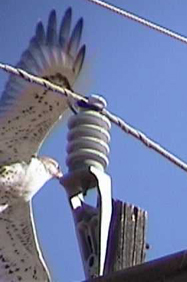
We saw another one, below, also a male juvenile, in late January of 2007, also observed on a power pole along Cascabel Road. (Click on each image to enlarge it.)
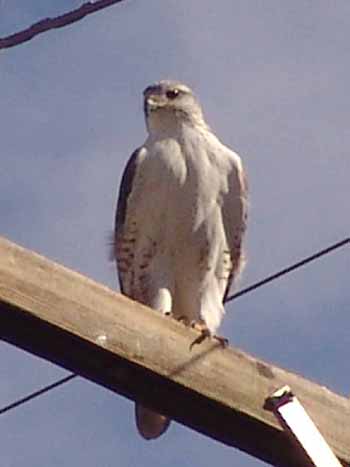 ....
....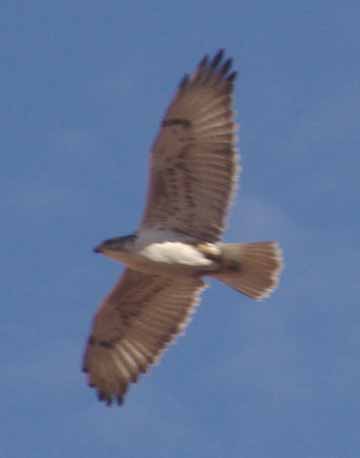
Since we have many images of our Ferruginous Hawks, we have decided to devote a separate page to chronicle the variety of these birds. See this link:
Ferruginous Hawk
Zone-tail Hawk & Mexican Black Hawk
(Buteo albonotatus & Buteogallus anthracinus)
These two visually very similar Buteo-like hawks summer in Hot Springs Canyon, and are not always easy to distinguish (see below for more discussion). They have long, chicken-like yellow legs.
(Click on each image to enlarge it.)
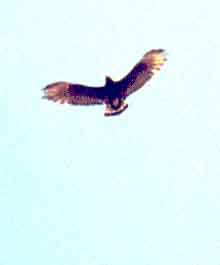 .
.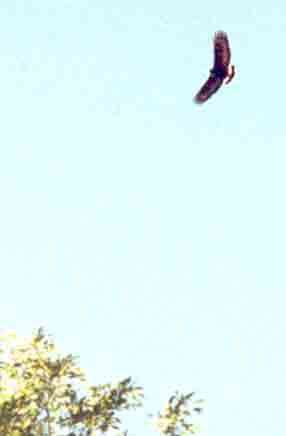 .
.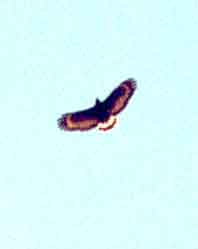
Since these images were taken with a vintage 2000 video camera, their distinguishing features are subtle but still telling. First, note that the (yellowish) legs of the bird above left extend well below the line of wings, and that faint bars may be seen above the larger white-bar of the tail, while the two birds shown to its right look different: the wings of these birds are considerably broader; the tips of the secondary feathers extending back to the fan of the tail feathers, while those of the bird at the left do not extend back so far. The wings of the Common Black-Hawk (middle and right images) are broader than those of the Zone-Tail (left image).Also, the major White Band of the tail is broader and more striking on the Common Black-Hawk than is the white banding of the Zone-Tail. We often see both of these black hawks flying (and often along with Vultures) in the air over Hot Springs Canyon during the summertime. The Zone-Tail in particular looks like a Turkey Vulture when flying overhead.
Harris's Hawk
Gray Hawk
Accipiters
Cooper's Hawk (Accipiter cooperii)
One of the accipiter hawks (long-tailed, rather short-winged woodland raptors with rounded wings, adapted for agile pursuit of small birds among trees and shrubs), the Cooper's Hawk is one of our most frequently encountered hawks, living with us year-round as it flies low among the mesquite and palo verde trees. It is hard to distinguish from the Sharp-shinned Hawk.
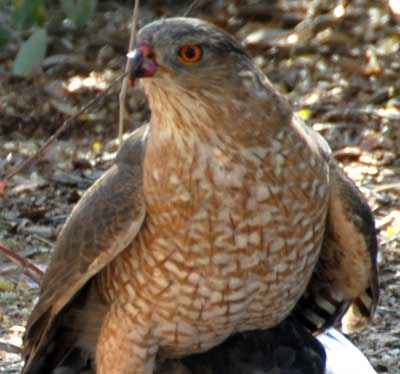 .
.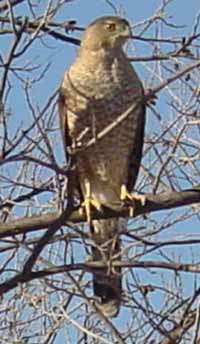 .
.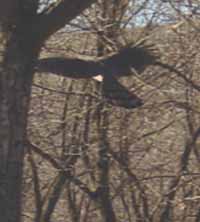
These photographs of a juvenile Cooper's Hawk, below, show two features that, according to Sibley 2000 and to Wheeler & Clark 1999 (cited on main Bird page, p. 112 and pp. 32-37 respectively), contrast with the Sharp-shinned Hawk: at left, the leg is stouter, less "stick-like" than the sharp-shinned, while at right, the dark streaks on the breast and sides are thinner (less coarse). Note also that this bird has a band on its left leg.
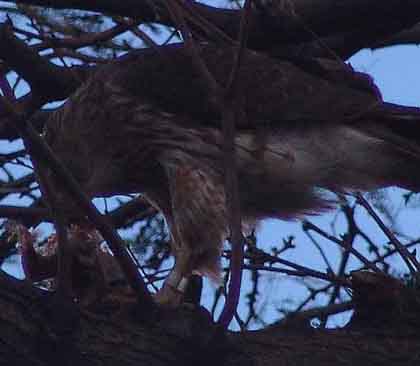 .....
.....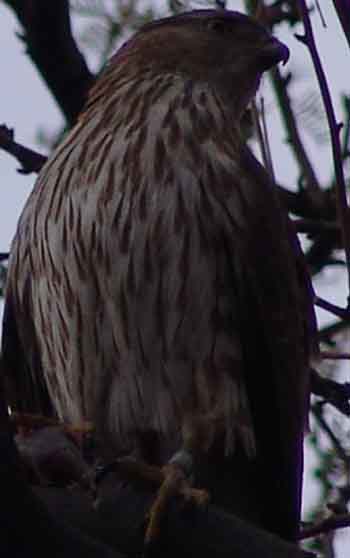
This image below, taken by Athol Cline near 5th St. and Chantilly in Tucson on March 25, 2008, shows what is obviously a kinship-pair of Cooper's Hawks perched in a eucalyptus tree. While the venue is outside our area, the two distinctive color patterns seen together seem to make it useful for this page.
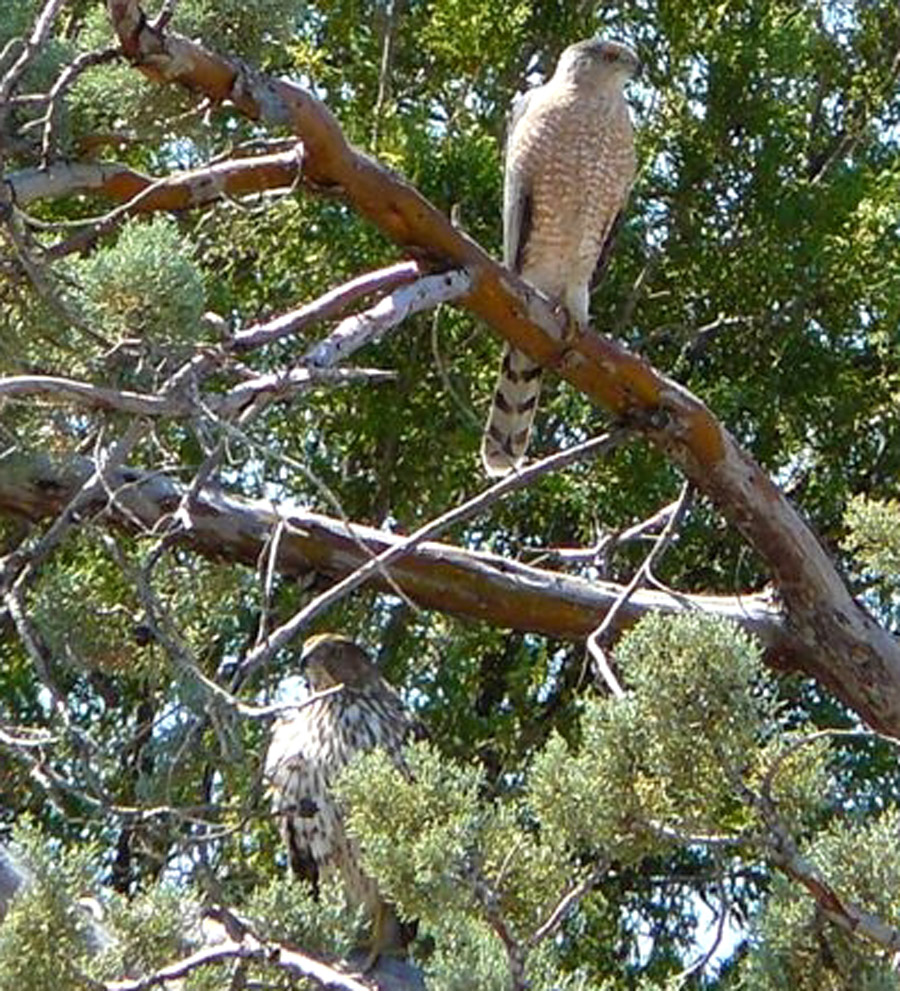
Falcons (Family Falconidae)
American Kestrel (Falco sparverius)
The size of a Jay, this falcon is distinctive in its ability to hover. It "is often seen hovering or perched on wires in open areas, hunting insects and small mammals" (Sibley, 2000, cited on main bird page, p. 131) The smallest and most delicate American falcon, it is long-winged and long-tailed. It occupies our area year-round.
Below, a long-shot view of a Kestrel perching on a power line on the high terrace of Lower Hot Springs Canyon, January 2006. This shows the distinctive color patterning of the head, the matte-brown breast, spotted belly, and the distinctive blue outer wings of a male.
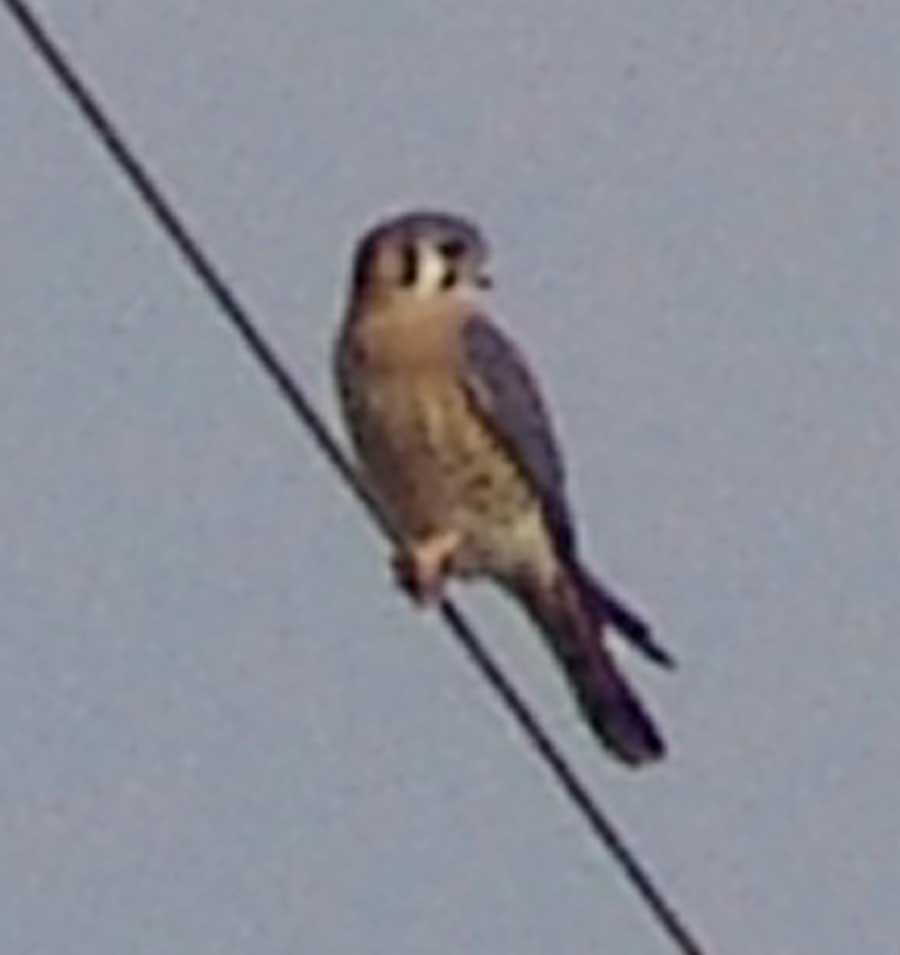
The photographs below are also not of good resolution, but they do show the facial patterning and the reddish-colored back, as well as the whitish rump.
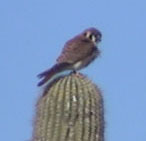 .
.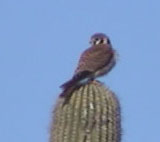 .
.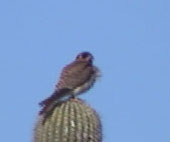 .
.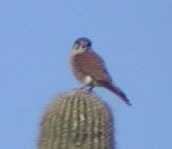
Below left, a Kestrel perches on a dead tree below the Red Tank in September 2006. At right, joined by a Mourning Dove, it looks away. (Click on each image to enlarge it.)
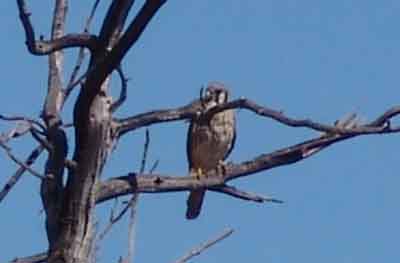 ..
..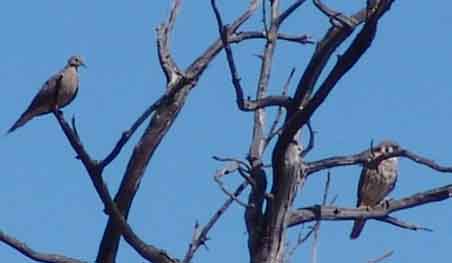
Below, this falcon-like bird was seen hovering, in substantial winds, high above the cliffs of Lower Hot Springs Canyon in March 2005. The day was too gray, and the raptor too high, to make out details other than these silhouettes, but it did seem to be larger than a Kestrel: (Click on each image to enlarge it.)
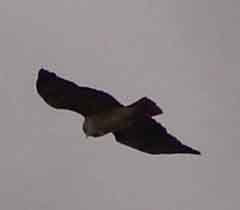 ...
...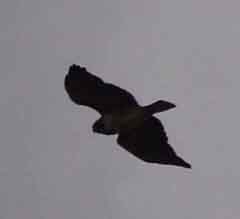 ...
...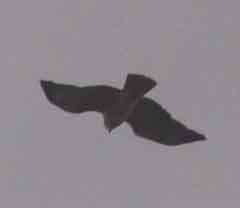
...............
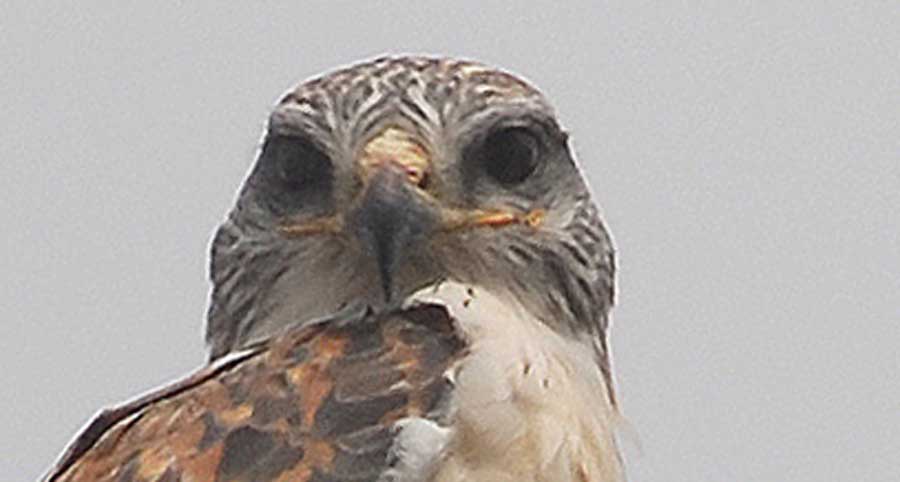
Return to Birds
